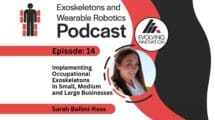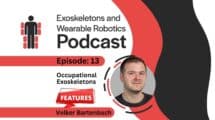The Japanese exoskeleton manufacturer and one of the largest exoskeleton companies in the world, CYBERDYNE Inc., has obtained marketing clearance from the U.S. Food and Drug Administration (FDA) for its HAL for Medical Use (Lower Limb Type), also referred to as “Medical HAL.” Starting Dec 17th, the company can expand the marketing efforts of the HAL, which stands for Hybrid Assistive Limb, into the U.S. The Medical HAL is now approved for use in Japan, the EU, and the U.S.
Medical HAL obtaining FDA marketing clearance now joins ReWalk, Ekso Bionics, and Indego in the U.S. market for walking assistance and rehabilitation mobile, powered exoskeletons. CYBERDYNE applied to the FDA on June 19th 2017, but only after completing preliminary discussions. This is a six-month turn around period which suggests that the FDA is becoming more comfortable with evaluating powered exoskeletons.
During the evaluation process, the company focused on some key differences of the Medical HAL compared to the Ekso GT, ReWalk, and Indego:
- Medical HAL primarily uses “surface electromyography bioelectrical signals” collected directly from the patient’s muscles and nervous system to control the movements of the device.
- Medical HAL is designed to be used as a “gait training device.” The main goal is for the user to show at least temporary ambulation improvement without wearing the HAL after completing a gait training program.
As a result, Medical HAL is now the only powered exoskeleton classified by the FDA under both Neurological Devices §21 CFR 882.5050 and Physical Medical Devices §21 CFR 890.3480 categories.
The Medical HAL FDA approval has also lead to some changes to FDA classifications:
- FDA definition for powered exoskeleton has been changed:
- Old:
A powered exoskeleton is a prescription device that is composed of an external, powered, motorized orthosis used for medical purposes that is placed over a person’s paralyzed or weakened limbs for the purpose of providing ambulation. - New:
A powered exoskeleton is a prescription device that is composed of an external, powered, motorized orthosis that is placed over a person’s paralyzed or weakened lower extremity limb(s) for medical purposes.
- Old:
- Definition of Physical State has been changed:
- Old:
The device is a wearable exoskeleton device that allows the user to enable ambulation over the course of the day. The control of the device is achieved through a wrist-worn user-operated wireless communicator, tilt sensor and specific body movements. - New:
The device is comprised of external, powered, orthotic components that rely on controllers and/or sensors.
- Old:
- Technical Methods:
- Old:
The movement of the swing leg is controlled by a seat of gears and DC motors at the knee and hip joints. Minimizing energy expenditure with gait approximation is critical for maximizing battery life between charges. - New:
The device facilitates movement of one or multiple lower extremity joints (e.g. hip, knee, ankle).
- Old:
- Target Area:
- Old:
The device legs consist of left and right interconnect hip and knee segments. Multiple attachment straps are mounted along the length of each leg. The pelvic band support provides a structure to join the two legs together and the pelvic strap helps hold the user firmly in the system. A tilt sensor is mounted on the left side of the pelvic band. The ankle/foot bed holds the calves of the user to the system. - New:
The device is intended to be used on the lower extremity. It may be used unilaterally, bilaterally, on a single joint, or on multiple joints.
- Old:
This is not all – Cybernic Treatment!
CYBERDYNE is also planning to establish a joint venture with Brooks Rehabilitation (Florida) to open a Cybernic Treatment Center. What is Cybernic Treatment? In short, the company claims that the Medical HAL’s use of surface electromyography bioelectrical signals better integrates the device in a brain-nerve-physical system. The HAL will not move until it detects a strong electrical signal, ideally one of the users attempting to move the limb being assisted. This creates a stronger cause-and-effect dynamic between the user and powered exoskeleton. In short, this makes the Cybernic Treatment not only equivalent to physical therapy under the guidance of multiple therapists manually moving the user’s limbs but “a new treatment procedure, distinct from other traditional rehabilitation procedures.” Note that the Cybernic Treatment is not limited to the Medical HAL.
CYBERDYENE’s stock was up almost 20% after the official press release (Cyberdyne Inc TYO:7779).
Update March 19, 2018
In March, the company announced it has established to commence operations in the U.S. and to market the Medical HAL to the entire U.S. from its Brooks Cybernic Treatment Center. A new video, highlighting the efforts was also uploaded on YouTube:
Sources & Further Reading:
CYBERDYNE obtained marketing clearance from U.S. FDA for Medical HAL as a medical device, CYBERYDNE INC, Dec 19, 2017, https://www.cyberdyne.jp/wp_uploads/2017/12/171219_FDA_ENG_1.pdf
Product Classification – Powered Exoskeleton, U.S. Food & Drug Administration, Dec 18, 2017, https://www.accessdata.fda.gov/scripts/cdrh/cfdocs/cfpcd/classification.cfm?ID=3742
Featured Image: Image of Cybernic Treatment using the Medical HAL (Cyberdyne Care Robotics, Bochum, Germany)








1 Comment